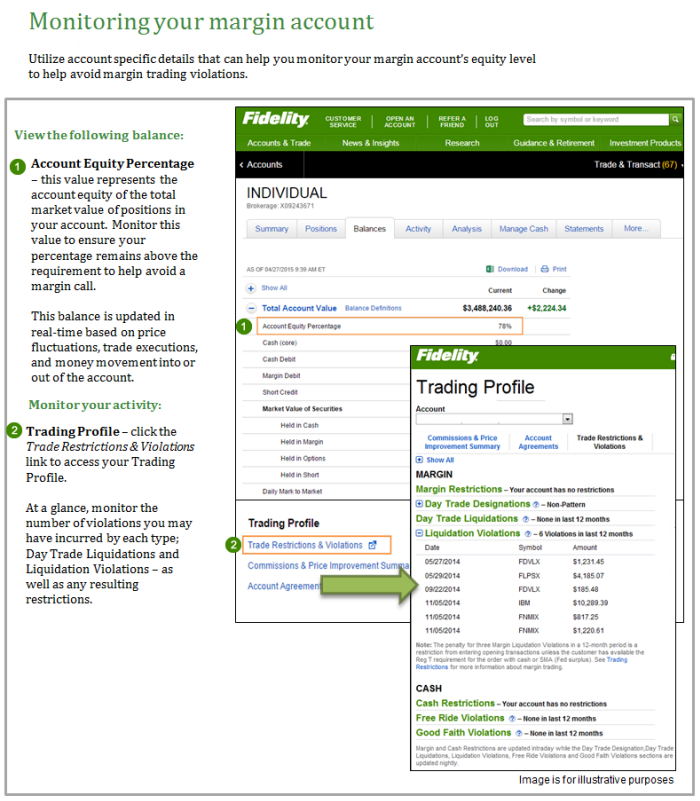Margin equity requirements
Trading on margin involves additional risks and complex rules, so it's critical that you understand the requirements and industry regulations before placing any trades. When you trade on margin, you are essentially borrowing against the value of your securities in an effort to leverage your returns.
To remain in the good graces of your brokerage firm, you must meet and maintain certain equity levels, including initial and "house" margin requirements. Most brokerage firms maintain house margin requirements that exceed the minimum equity requirements set forth by regulators. For more on this topic, please read Meeting the requirements for margin trading.
If the equity in your margin account falls below your firm's house requirements, most brokerage firms will issue a margin call. When this happens, you will need to take immediate action to increase the equity in your account by depositing cash or marginable securities, or by selling securities. If you fail to act promptly, your broker may go ahead and liquidate shares in your account without any advance notification. In fact, your broker can liquidate your margin account holdings without even issuing a margin call. For this reason, you should monitor the equity levels in your margin account closely to avoid unanticipated liquidations.
Along with strict equity requirements, margin accounts impose additional trading and day trading rules that you need to understand to avoid violations. If you use your margin account to purchase and sell the same security on the same business day, those transactions qualify as day trades. If you execute day trades frequently, it's likely that you will have to comply with special rules that govern "pattern day traders."
A pattern day trader is defined as someone who executes 4 or more day trades in a period of 5 business days. The number of day trades must comprise more than 6% of your total trading activity for that same 5-day period.
As a pattern day trader, you are limited to trading up to 4 times the maintenance margin excess in your account (also known as exchange surplus), based on the previous day's activity and ending balances. As discussed in Margin requirements for day traders, you must maintain a minimum of $25,000 of equity in your account at all times and some securities are not eligible for pattern day trading.
Let's examine 2 of the more common margin trading violations you should understand in more detail.
What is it? A margin liquidation violation occurs when your margin account has been issued both a Fed and an exchange call and you sell securities instead of depositing cash to cover the calls.
If you are a pattern day trader and you sell positions you opened during the same day, you will not incur a margin liquidation violation. However, if you hold the position overnight, your account could be in a Fed and exchange call. Selling your position the following business day would create a margin liquidation violation.
The following example illustrates how Justin, a hypothetical pattern day trader, might incur a margin liquidation violation:
Margin liquidation example – Justin:
- Intraday buying power = $100,000.
- Today, Justin buys $100,000 of ABC stock. He reviews his margin account balances and understands that he is very close to being in an exchange call, but is not overly concerned because he is planning on selling the stock before the market closes today.
- Later in the day, the price of ABC stock declines and Justin realizes that if he sells his shares he will incur a loss. He decides to hold the shares overnight and hope for the price to rise the next day.
- At the end of the day, Justin reviews his margin account balances again and finds that he is in both a Fed call and an exchange call.
- The following day, Justin decides to sell his ABC stock to cover the calls.
Justin would incur a margin liquidation violation because he was in a Fed and exchange call at the same time and liquidated the position that caused the calls.
Consequences: If you incur 3 margin liquidation violations in a rolling 12-month period, your account will be limited to margin trades that can be supported by the SMA (Fed surplus) within the account. This restriction will remain in place for 90 calendar days, or one year from the first liquidation, whichever is longer.
What is it? A day trade call is generated whenever you place opening trades that exceed your account's day trade buying power and then close those positions on the same day. You then have 5 business days to meet a call in an unrestricted account by depositing cash or marginable securities in the account. During the day trade call period, the account is reduced to 2 times the exchange surplus from the previous day, with no use of time and tick.
The following example illustrates how Julie, a hypothetical day trader, might incur a day trade call.
Day trade call and liquidation example – Julie:
- Today, Julie buys and holds a position in XYZ stock overnight, using most of her intraday buying power.
- The next day, she begins the day by selling her shares of XYZ stock.
- This trade generates additional margin buying power, so Julie uses the proceeds of the XYZ sale to buy shares of ABC stock. The brokerage system allows Julie to make this trade because it assumes she will be buying and holding the shares overnight.
- After ABC Company announces some bad news, its stock price suddenly drops, causing Julie to sell her shares.
Because Julie was using margin buying power and not day trade buying power, this creates a day trade call. Day trade buying power remains fixed and is based on balances from the previous day. It cannot be increased by selling previously held positions.
The preferred method for covering a day trade call is to make a deposit for the amount of the call. If this is not possible, Julie does have the option of liquidating positions in her account to cover the call, but such transactions will be considered day trade liquidations.
To meet most day trade calls through liquidation, multiply the amount of the call by 4 (or divide by 25%) to arrive at the amount of stock that would need to be sold to satisfy the call. Leveraged ETFs or other securities with higher margin requirements would be based on the amount of the call/exchange requirement.
Consequences: Traders are allowed 2 day trade liquidations within a rolling 12-month period. However, if you incur a third day trade liquidation, your account will be restricted. Your day trade buying power will be reduced to the amount of the exchange surplus, without the use of time and tick, for 90 calendar days. After the 90-day restriction period, the rolling 12-month calendar resets.
As these examples illustrate, it's easy to encounter problems if you are an active trader and don't fully understand margin account trading rules and how to decipher your margin account balances. That's why it is important to review these rules prior to opening a new position in your margin account. See where you can find account specific details on Fidelity.com to help monitor your margin account



